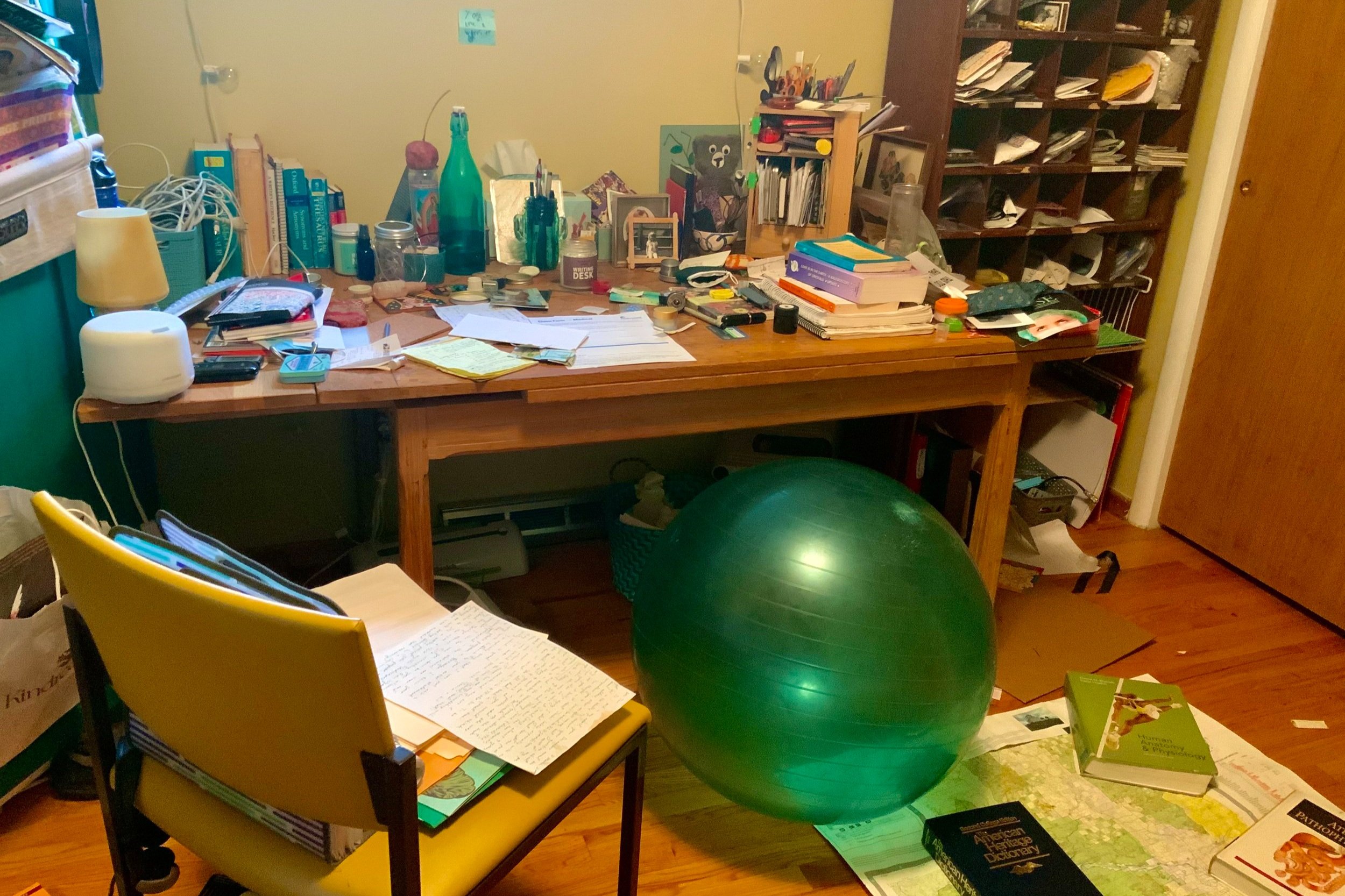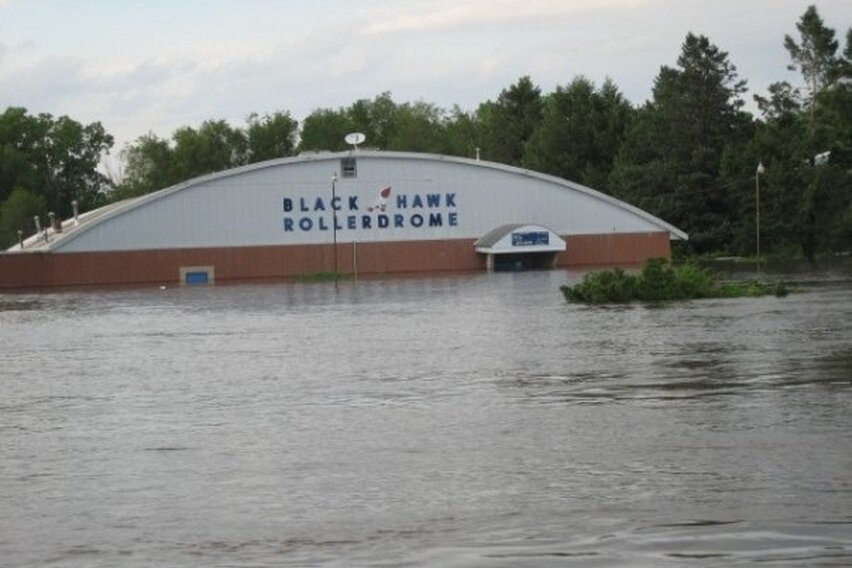A Flooded River Versus a Flood of Volunteers
The author’s “disaster area.” (Source: Author.)
I got a text the other day from my friend, Barbara, asking, “Are you in a disaster area?”
I glanced around my office, rolling around on an exercise ball, since my chair was heaped with file folders. On my desk were piles of papers, books, push pins, and pens, and a scattering of alcohol pads and paper towels I’d scribbled important notes on at work, rescued from my scrub pockets the last time I did laundry. A map of the Selway-Bitterroot Wilderness lay unrolled, pressed flat under dictionaries and old nursing textbooks in anticipation of my upcoming summer on a fire lookout.
Was I in a disaster area? I thought about taking a photo of the room and texting it in reply to Barbara’s question, along with the shrug emoji.
But I knew that wasn’t what she was referring to.
Parts of Montana are currently flooded, and though my corner of the state remains above water, Barbara lives in Iowa, and has been watching houses in Montana being carried away by raging rivers on the national news. It makes sense she would be concerned about the only person she knows in Montana. Besides, floods are a part of Barbara’s and my shared history.
When I moved to Iowa in 2008 to attend nursing school, I lived with Barbara in her house on Schrieber Street in Cedar Falls along with my dog Bandit, a few cats, and Oscar, Barbara’s diabetic pug. Oscar goes down in history as my first practice patient, as I gave him his morning insulin shots in the fat roll where his neck should have been.
That June, after a historically wet spring, the northeast Iowa watershed became so supersaturated with torrential rains that rivers escaped their banks, submerging a portion of the state.
Watching flooding footage on the evening news kept the situation at the front of our minds, but still at a distance, still upstream, until the day someone official marched into the Pharmacology classroom, where my classmates and I were practicing injections on oranges, and announced that the Cedar River had crested.
We had about one hour to get to our respective homes before arterial routes through the city closed down. It was a little bit thrilling and a little bit scary, like when blizzards in my childhood were wild enough to close schools in Minnesota.
It was hard to believe we were in a state of emergency as I rode toward home that afternoon on dry streets, the air hot and sticky under a bright sun. Peonies were in full bloom, and baskets of geraniums, impatiens, and fuchsias decorated front porches.
But when I turned onto the bike path, and down a hill into thigh-deep water, suddenly, the flood was real.
Though getting home safe was the goal, once I was there I couldn’t imagine staying. I wasn’t the kind of student to use the time afforded by canceled classes to get ahead in my reading, so I rode downtown to join a sandbagging effort that was underway to make myself useful.
Flooding in Cedar Falls, IA. (Source: Author.)
Down at the staging area, I gravitated toward a cheerful woman who exuded the kind of enthusiastic authority of a camp counselor, a scout leader, or a motivational speaker. I joined forces with her, and her three, school-aged children, shoveling in unison under the scorching sun like a well-oiled machine.
Soon we had filled a small trailer behind an ATV with sandbags, and waited for another empty trailer to load. Leaning on our shovels, the woman wiped her brow off with a bandana and asked me about where I lived, and how close my place was to the rising waters.
I told her I was actually from Montana, just staying with a friend while I finished my nursing degree. For some reason I wanted to make it clear that I didn’t have much at stake, that Cedar Falls wasn’t really my town, but I wanted to lend a helping hand.
“We’re glad you’re here,” she told me, squeezing my sunburned arm. Somehow, I felt her words all the way to my toes.
As I shoveled, I thought about my classmates, my teachers, and the white-haired jogger I passed on the bike path every morning who always sang out, “Gooooood Mor-ning!” I thought about Cup of Joe, the coffee shop where I studied, people watched, and was getting to know some of the regulars by name. I pictured the man next door on Schreiber Street who kept a coffee can full of steak bones for Bandit, and the one across the street who’d given me a jump start early one morning when I’d left my dome light on all night. I pictured Barbara, the cats, and giving insulin shots to Oscar the pug, and for the first time since I’d moved to Iowa, it all felt something like home.
Soon, another couple joined our cacophony of clinking shovels. They told the story of being up all night moving their horses, sheep, and pigs to higher ground. They had a cooler full of bottled water to share, and we paused for a cold drink before getting back to the business of saving our town.
At some point, a man with a walkie talkie in a neon-yellow mesh tank top showed up and questioned my ability to lift the 40-pound sandbags. He suggested I fill the bags less full, to save my back. I hesitated before telling him I used to roll rocks uphill in the Grand Canyon for a living, which was just a humorous spin on the truth.
Later in the day when he and I were side by side, stacking full sandbags on top of the levee, he told one what became one of my favorite jokes ever:
What did the fish say when it swam into a cement wall?
DAM!
The author posing with some sandbags. (Source: Author.)
On a trip back to Cedar Falls last month, fourteen years since the flood, I stopped in at Cup of Joe. I hadn’t remembered how close it was to the river—right across the street, in fact, from the levee that ultimately saved downtown.
Inside Cup of Joe’s, the air was warm with rich, roasted coffee beans, buzzing with the hiss of milk being steamed. In one corner, there was a couple putting together a jigsaw puzzle, in the other, a man in a bowler hat doing a crossword puzzle. At the big table in the middle sat a group studying Pathophysiology. Nursing students: I’d recognize my people anywhere.
I wanted to pull up a chair and indulge in nostalgia, to reminisce about the flood, the sandbags, and how close Cedar Falls came to total disaster; but I realized the students were probably toddlers during the 2008 flood.
I finished my coffee and coasted my bike through the historic downtown, vibrant and alive, remembering the doorways stacked with sandbags, and handwritten notes in store windows announcing personal emergencies, and temporary closures.
I spent the rest of the morning meandering down the bike path. The river was swollen with spring rains, but still behaving itself, staying within its banks.
I rode my old route between home and school. Though I thought I’d never forget it, I couldn’t locate the exact spot where thigh-deep water turned me around on that hot June afternoon in 2008 when the river crested.
I looked for the emergency staging area where I’d filled sandbags, but couldn’t find it either, probably because once the flood was over, it went back to just being a regular parking lot.
Luckily though, the thing that was easy to find, right where I’d left it, was this story.
Read more of our weekly Neighborhood Storyteller columns here!




Karla Theilen is the Neighborhood Storyteller at Strong Towns. Karla is a writer, storyteller, and Registered Nurse based out of Missoula, Montana. Her penchant to explore wild places informed early career choices as a trail builder in the Grand Canyon, and a forest fire lookout in Idaho. Her current writing inspiration comes from a different kind of wilderness, navigating healing journeys with her patients in far-flung places where she works as a travel nurse. Her writing has been featured on NPR, and select stories and essays have been anthologized. She has been Facebook-free since 1972.